Welcome to our Colossus Movie Guide for Vertigo. This guide contains everything you need to understand the film. Dive into our detailed library of content, covering key aspects of the movie. We encourage your comments to help us create the best possible guide. Thank you!
What is Vertigo about?
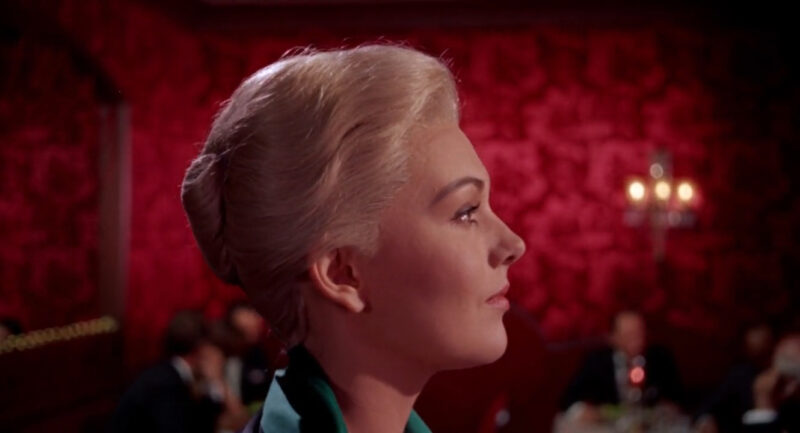
Vertigo is a cinematic exploration of the complexities of human identity and obsession, unraveled through a masterfully spun narrative. The movie delves deep into the psyche of Scottie—and, by extension, the audience—to reflect upon the unnerving influence of fascination and the distortion of reality it can breed. As a striking metaphor, vertigo not only signifies Scottie’s physical affliction but also serves as a symbol of his emotional and psychological spiral into an abyss of fixation.
The story’s layered narrative speaks volumes about the manipulation of identity and reality. Judy is shaped and reshaped according to Scottie’s delusion of Madeleine, blurring the boundaries between real and perceived. This theme echoes the audience’s experience. We are led down a path that constantly alters our perceptions, only to reveal a different reality at the end. The implications of the final scene, where Scottie confronts the truth of his manipulated reality, leaves a lasting impact, underscoring the dangers of an unchecked obsession and the fallibility of perception. Vertigo challenges viewers to confront the unsettling depths of human obsession and the distorted realities it can create.
Movie Guide table of contents
Cast
- James Stewart – John “Scottie” Ferguson
- Kim Novak – Judy Barton / Madeleine Elster
- Tom Helmore – Gavin Elster
- Barbara Bel Geddes – Marjorie “Midge” Wood
- Henry Jones – the coroner
- Raymond Bailey – Scottie’s doctor
- Ellen Corby – manager of McKittrick Hotel
- Konstantin Shayne – Pop Leibel
- Alec Coppel – Writer
- Samuel Taylor – Writer
- Alfred Hitchcock – Director
The ending of Vertigo explained
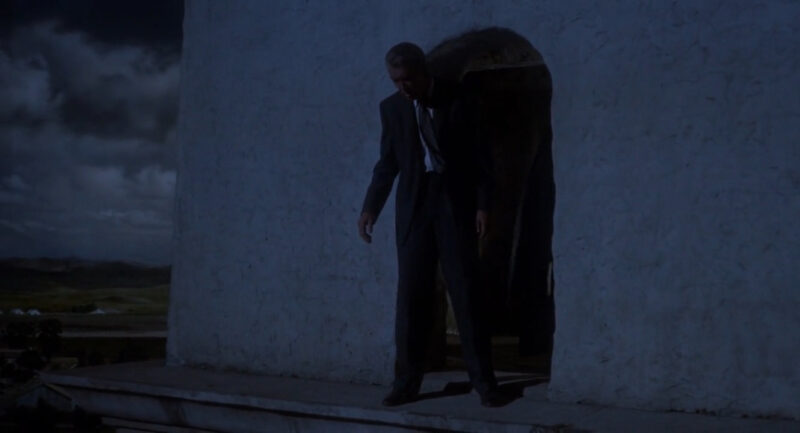
A recap of the ending
In a revealing flashback, we learn that Judy impersonated “Madeleine Elster” for Gavin’s murderous scheme. She starts a confession letter to Scottie but tears it, choosing love over truth. Even as they start dating, Scottie remains fixated on “Madeleine.” He coerces Judy into replicating Madeleine’s look. Upon seeing Judy don the necklace from Carlotta’s painting, Scottie unravels the deceit.
Driven to confirm his suspicions, Scottie takes Judy to the Mission, forcing a reenactment of the fatal event. He compels her to climb the bell tower and admit her treachery. At the top, Scottie overcomes his acrophobia and Judy confesses her part in Gavin’s plot. She pleads for Scottie’s forgiveness, declaring her love for him. Their moment is disrupted by a nun’s appearance, causing a startled Judy to fall to her death. Scottie is left mourning yet again, free from his acrophobia, as the nun tolls the bell.
The irony of Scottie’s obsession
Scottie’s compulsive need for composure and control is a critical aspect of his character in Vertigo, and ironically, it’s this obsession with control that triggers his psychological unraveling and indirectly causes Judy’s death, leading to his further mental torment.
From the beginning, Scottie is portrayed as a man seeking to regain control over his life, particularly through overcoming his acrophobia. His trauma, represented by his vertigo, is a constant challenge to his sense of control. Meeting and falling in love with Madeleine offers Scottie a form of purpose and control he’s been longing for. However, her supposed suicide, an event utterly out of his control, shatters his composure, pushing him into a state of depression.
His encounter with Judy, who bears a striking resemblance to Madeleine, rekindles his obsessive need for control. Scottie seeks to reshape Judy into the image of Madeleine, a clear manifestation of his desire for control. In this process, Scottie doesn’t merely wish to dictate Judy’s appearance—he aims to manipulate reality itself, trying to resurrect Madeleine through Judy.
But Scottie’s quest for control escalates to a point where it consumes him and eventually catalyzes his psychological disintegration. The more he exerts control over Judy, the more he is entrapped in his obsession. His growing obsession with the truth and his unyielding desire to control reality lead him to the Mission.
There, Scottie forces Judy to confess and attempts to reenact the tragic event. His momentary triumph over his vertigo, a personal victory and a regained sense of control, is overshadowed by the horror of Judy’s death. This tragic event marks the culmination of his obsession with control, and paradoxically, it leads to his complete loss of it.
Judy’s death deeply traumatizes Scottie and plunges him into further mental anguish. The woman he once controlled falls beyond his reach, echoing Madeleine’s death, and leaving him enveloped in grief. His quest for control leads him to a point where he loses not only his composure but also the person he is obsessed with.
Hitchcock’s meta-narrative and audience manipulation
The meta-narrative in Vertigo is a clear representation of Alfred Hitchcock’s mastery over the art of suspense and audience manipulation. Throughout the film, Hitchcock cleverly hides Judy’s true identity from the audience, making them complicit in Scottie’s delusions—then rips the rug from under our feet right at the very end.
This unexpected disclosure shifts the audience’s perspective and perception of the entire narrative. In retrospect, the audience is made aware of the layered manipulations at play, mirroring Scottie’s eventual realization of truth. By revealing the truth to the audience before Scottie, Hitchcock creates a dramatic irony that deepens the suspense and engagement.
Moreover, Hitchcock’s meta-narrative is essentially a commentary on the nature of cinema itself. Cinema often deals with illusion and reality, and Vertigo exemplifies this. Hitchcock, as the director, is the puppet master controlling not just the characters on screen but also manipulating audience perceptions, much like Gavin Elster in the film. This approach reveals the inherent power of the director in shaping narrative and manipulating audience reactions.
Hitchcock’s manipulation of the audience also serves as a critique of viewer passivity. By being deceived alongside Scottie, the audience is challenged to question their passive acceptance of the narrative presented to them. Hitchcock encourages viewers to be more discerning and critical, transforming them from passive spectators to active participants.
How the ending mirrors the opening scene
The final scene in Vertigo masterfully mirrors the opening sequence that triggers Scottie’s acrophobia, thereby offering a profound closure to his character journey. Both scenes feature a high structure, a traumatic event, and a consequential fall, yet they play out differently for Scottie, marking his evolution throughout the film.
The opening scene sets the stage for Scottie’s journey. A rooftop chase ends in the tragic death of a fellow police officer, which Scottie witnesses while paralyzed by his acrophobia. This incident deeply traumatizes Scottie and instills in him an intense fear of heights, or vertigo, shaping his future actions and decisions. It is this initial trauma that leads him to retire from the police force and eventually become entangled in Gavin’s manipulative plot.
The climax at the Mission bell tower, on the other hand, serves as a parallel to the opening but with significant differences. Just like in the opening sequence, Scottie finds himself high above the ground, facing a traumatic event—this time, it’s Judy’s confession and her subsequent fall. However, unlike the opening scene, Scottie is now able to conquer his acrophobia and reach the top of the bell tower, showing his growth and the overcoming of his fears.
The two scenes provide a mirror reflection of each other in Scottie’s journey: from a traumatized, acrophobic man to someone who has overcome his fear. However, the victory over his acrophobia doesn’t bring relief or happiness but is instead coupled with another tragedy, marking an ironic and poignant turn in Scottie’s journey.
Additionally, the cyclical nature of these events—starting and ending with a fall—reinforces the film’s recurring theme of the past’s influence on the present. Even as Scottie overcomes his personal fear, he is unable to prevent the past from repeating itself, emphasizing the persistent grip of the past on present circumstances.
The role of religion in the final scene
Religion plays a significant role in the final scene of Vertigo, adding layers of symbolism and depth to the narrative. The setting in itself, a Spanish mission, replete with religious undertones, serves as a backdrop to the culmination of the film’s thematic exploration.
The religious context of the final scene can be perceived as a metaphor for judgment and penance. The bell tower, a quintessential symbol of religious institutions, can be seen as a representation of a higher power or divine judgment. When Scottie forces Judy to the top of the tower to confess her deceit, it’s almost as if she is brought before a higher court to admit her sins. In a sense, this confrontation and confession can be seen as a form of penance for Judy.
Judy’s subsequent fall to death could be interpreted as a tragic form of divine retribution, an immediate consequence following her confession. It echoes the “eye for an eye” principle, where her deception leads to her downfall, much like how her act of impersonation led to Madeleine’s death.
The unexpected appearance of the nun plays into the religious symbolism. The nun, a representative of moral authority and piety in traditional Christian iconography, startles Judy, resulting in her accidental fall. The nun’s subsequent act of ringing the mission bell can be interpreted as a toll for the departed soul, a common practice in many religious customs.
However, while the religious symbolism lends dramatic weight to the final scene, it’s worth noting that Hitchcock uses these elements more for their metaphorical value rather than an endorsement or critique of religious beliefs. The religious elements in Vertigo contribute to the film’s exploration of themes such as guilt, sin, judgment, and retribution, enhancing the richness of the narrative.
The power of guilt
The ending also serves as the final reveal of truth, marked by Judy’s confession. Her guilt stems from her participation in Gavin’s manipulative plot, which resulted in Madeleine’s death and caused Scottie’s psychological trauma. The audience witnesses the extent of her guilt in the scene where she starts writing a confession letter to Scottie, only to tear it up. This moment reveals Judy’s inner turmoil—her guilt for the past and her desire to be loved by Scottie for who she truly is, not as Madeleine.
The decision to return to Scottie, despite the potential risks, is a testament to the power of her guilt and her love for him. She chooses to continue the charade, hoping that she can find happiness with Scottie and, perhaps, redemption for her past actions. She transforms herself back into Madeleine, even though it brings back painful memories and guilt, reinforcing the power of guilt and its influence over her actions.
However, the revelation of truth, when it finally comes, proves to be devastating for both Judy and Scottie. Judy’s confession, induced by Scottie’s insistence, not only shatters Scottie’s illusion but also amplifies Judy’s guilt. It becomes clear that her attempts at reconciliation and redemption have backfired, leading to tragic consequences.
Judy’s guilt and the reveal of truth also provide the audience with a deeper understanding of her character. Until this point, Judy was seen primarily as the deceptive figure, the femme fatale. But the exposure of her guilt humanizes her, making her a more relatable and tragic figure.
The themes and meaning of Vertigo
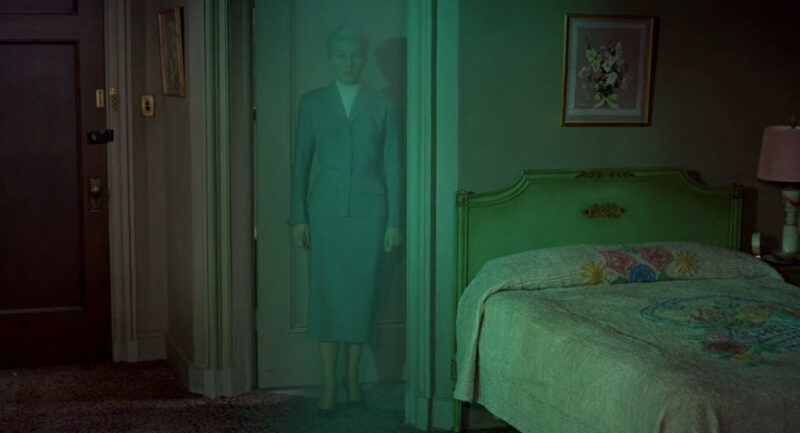
The layers of obsession
One of the most striking themes in Vertigo is obsession, which is illustrated primarily through the character of Scottie, who falls into a vortex of fixation with Madeleine and, subsequently, Judy. His obsession is a central element of the narrative and directly links to his emotional and psychological vertigo.
The objectification of our obsessions
Scottie’s obsession begins as a curiosity about Madeleine’s peculiar behavior and quickly spirals into a fixation that begins to dominate his life. He starts following her around San Francisco, monitoring her every move, and subconsciously starts molding his life around her. After Madeleine’s apparent death, Scottie’s obsession deepens as he is driven to the brink of insanity, haunted by images of her. The “vertigo” of his obsession renders him incapable of distinguishing between the image of Madeleine he fell in love with and the reality of who she was.
When Scottie encounters Judy, his obsession takes on a new form. Recognizing in her a resemblance to Madeleine, he is determined to recreate the dead woman’s image in Judy. He imposes his desires and memories of Madeleine onto Judy, indicating the transformation of his obsession into a harmful force that erodes Judy’s individuality. This highlights a deeper aspect of the theme of obsession: the objectification of the subject of obsession. Judy, in Scottie’s eyes, becomes merely a vessel to fill with his memories of Madeleine, showing how obsession can rob a person of their identity.
The destructive force of obsession
Judy’s tragic death at the end of Vertigo is a direct result of the destructive force of obsession, a theme that pervades the film. Her demise, precipitated by Scottie’s obsessive pursuit of a lost love, serves as a stark reminder of the deadly consequences of unchecked fixation.
In the climactic scene at the mission, when Scottie forces Judy to relive the trauma of Madeleine’s death, we see the full impact of his obsession. Judy is terrified, not just of the physical height, but also of Scottie’s intense, unyielding fixation. His obsession has reached its breaking point, pushing Judy to the brink.
When a shadowy figure (a nun from the mission) emerges from the darkness, Judy recoils in fear and accidentally falls to her death from the bell tower. The sudden appearance of the figure triggers her panic, but it is the relentless pressure of Scottie’s obsession that drives her to the edge, both literally and metaphorically. The unyielding force of his fixation creates an environment of fear and tension that ultimately leads to Judy’s tragic fall.
Judy’s surrender to Scottie’s obsession leads to her ultimate demise. She allows herself to be molded into the image of another woman, erasing her own identity in the process. In a sense, she was dead even before she fell.
How manipulation defines our identities
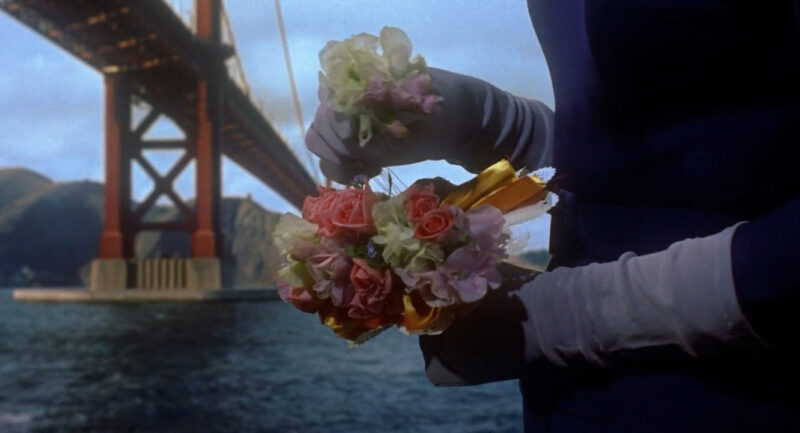
Vertigo explores the theme of identity and manipulation extensively, primarily through the character of Judy, who is forced to adopt a new persona to enact Gavin Elster’s plot. The exploration of this theme raises questions about the nature of identity, the impact of external influences, and the destructive consequences of manipulation.
The nature of identity
The theme of identity and manipulation in Vertigo is integral to the plot, with the concept of identity being dissected, altered, and reconstructed throughout the narrative. This theme primarily manifests through the characters of Madeleine/Judy and Scottie, illuminating the complex interplay between personal identity, perceived identity, and manipulated identity.
In Vertigo, identity is depicted as fluid and malleable. Judy Barton, the real individual, is manipulated to become Madeleine Elster, the object of Scottie’s obsessive desire. This act of transformation is not just physical but also emotional and psychological, causing Judy to oscillate between her real self and the identity thrust upon her. Here, Judy’s identity is portrayed as a construct, shaped and reshaped to meet the demands of external forces.
Scottie, entranced by the allure of the mysterious Madeleine, becomes the orchestrator of Judy’s second transformation. Unknowingly, he manipulates Judy into becoming the image of Madeleine, the woman he believed he loved and lost. Scottie’s need to reclaim his lost love leads him to overlook Judy’s real identity, indicating how obsession can manipulate one’s perception of another’s identity.
The impact of external influences
This theme of identity and manipulation is not just central to the plot but also serves to critique societal norms and expectations. Madeleine, the quintessential “perfect woman” as envisioned by Scottie, is a reflection of the societal ideals of femininity. Judy’s transformation into Madeleine can be interpreted as a critique of societal pressures that mold women into desired archetypes.
The recurring manipulations of Judy’s identity also bring forth the implications of power dynamics in relationships. Scottie, driven by his obsession, exerts control over Judy, dictating her appearance and behavior to match his desired image of Madeleine. This power dynamic strips Judy of her agency, forcing her to surrender her identity to Scottie’s manipulations.
On a broader scale, Vertigo presents a philosophical exploration of identity. The film ponders the question: What defines a person’s identity? Is it their true self, as represented by Judy? Or is it the persona they project or are forced to adopt, as demonstrated by Judy’s transformation into Madeleine? Vertigo offers no clear answers, leaving the viewer to contemplate the nature of identity.
The consequences of manipulation
Manipulation in Vertigo serves as the driving force behind the plot and carries significant consequences for the characters, ultimately leading to a tragic end. The manipulation not only impacts the lives of the individuals involved but also shapes the narrative’s tone, pacing, and thematic development.
The most apparent consequence of manipulation in the film is Judy’s tragic demise. As discussed earlier, Judy’s identity is manipulated twice, first by Gavin and then by Scottie. This manipulation puts her on a path that eventually leads to her death. Judy’s life is tragically shaped by the desires and machinations of others, highlighting the destructive potential of manipulation. Her death is a grim reminder of how manipulation can strip an individual of their agency and selfhood, leading to fatal consequences.
Scottie, the primary subject of Gavin’s manipulation and the instigator of Judy’s transformation, also faces drastic consequences. Gavin’s plot manipulates him into falling in love with a woman who doesn’t exist. When Scottie realizes the truth, it shatters his reality, pushing him to the brink of madness. The manipulation he experienced leads to a debilitating mental breakdown, showcasing the psychological toll manipulation can exact.
Beyond the direct consequences on the characters, manipulation in Vertigo also significantly influences the audience’s perception and understanding of the narrative. The audience, much like Scottie, is manipulated by the storyline. The film leads viewers to believe in Madeleine’s existence, her apparent possession, and her tragic demise, only to later reveal it as a staged plot. This narrative manipulation engenders a sense of suspense and unease, aligning the audience’s emotional journey with Scottie’s and enhancing the cinematic experience.
The manipulation in Vertigo facilitates a profound exploration of the film’s core themes. Through the consequences it brings upon the characters, manipulation allows for a deeper examination of obsession, identity, and the boundary between reality and illusion. This theme forms the backbone of the narrative and imbues it with psychological depth and complexity.
The fine line between reality and illusion
The distinction between reality and illusion is a critical theme in Vertigo, employed to build suspense and engross the audience in the narrative’s psychological depth. This theme is intertwined with the themes of obsession and manipulation and contributes to the sense of vertigo experienced by both Scottie and the audience.
From the outset, Vertigo plays with perceptions of reality. Scottie is deceived into believing that Madeleine is possessed by a spirit when, in reality, he is being manipulated as part of Gavin’s scheme. This initial deception blends the line between the real and the supernatural and sets the stage for the greater deceptions to follow. Even after Madeleine’s apparent death, Scottie’s obsession causes him to see her everywhere, further blurring the boundary between reality and illusion.
The theme takes a darker turn when Scottie meets Judy. His obsession and inability to let go of his past love result in a desperate attempt to mould Judy into Madeleine, causing Judy’s real identity to dissolve into the illusion of Madeleine. Scottie’s perception of reality becomes so distorted by his fixation that he is unable to see Judy as a separate individual, showing the devastating psychological effects of obsession and the thin line between reality and illusion.
The culmination of this theme occurs in the final revelation of Gavin’s manipulation and Judy’s true identity. Here, reality brutally intrudes, shattering the illusion that Scottie—and by extension, the audience—has been led to believe. The revelation not only shocks Scottie out of his delusion but also forces the audience to reassess the narrative from a new perspective, highlighting the compelling interplay between reality and illusion in Vertigo.
Why is the movie called Vertigo?

At a base level, the title of the film refers to a physiological condition characterized by a sensation of spinning and loss of balance—a condition that Scottie suffers from. Yet, as one delves into the narrative, it becomes evident that the term “vertigo” carries far more significant, multifaceted symbolism that taps into the film’s exploration of obsession, manipulation, and the blurring of reality and illusion.
To understand the deeper implications of vertigo, it’s crucial to consider the physical sensation it describes: the disorientation, the loss of control, the terror of instability. These elements are intrinsically connected with Scottie’s journey. His obsession with Madeleine and later Judy induces a metaphorical vertigo, a spiraling loss of control as he plunges deeper into his delusions. He’s stuck in a dizzying cycle of his obsession, unable to extricate himself or distinguish between the woman he loves and the illusion he’s built. Just as physical vertigo disorients and destabilizes, so too does the emotional and psychological vertigo Scottie experiences.
Additionally, vertigo also highlights the film’s focus on manipulation. Judy, under Gavin Elster’s machinations, is transformed into the image of Madeleine, leading Scottie into a dance of deception. The plot twists and turns, pulling the rug out from under the audience repeatedly. The viewers, like Scottie, experience a form of “narrative vertigo,” our perceptions of truth and reality manipulated and subverted, leaving us in a dizzying swirl of uncertainty.
Yet another layer of the vertigo symbolism is present in the visual language of the film itself. The innovative camera techniques, particularly the dolly zoom or “vertigo effect,” mirror the protagonist’s disoriented mental state. By visually distorting space and depth, these shots mimic the sensation of vertigo, pulling the audience further into Scottie’s distorted perception of reality. The title, thus, not only encapsulates the plot and themes but also informs the visual style of the film, making it an integral part of the storytelling.
While the title Vertigo initially conveys the idea of physical imbalance, it profoundly represents Scottie’s emotional imbalance and the disorientation experienced by the viewers. The title is an intricate puzzle piece that, when placed in the wider picture of the narrative, reveals a deep commentary on the human capacity for obsession, the nature of reality and illusion, and the unsettling reality of manipulation. As such, ‘vertigo’ moves beyond a mere medical term, becoming a powerful metaphor for the psychological disarray and tumultuous emotional state induced by fixation, deceit, and the blurring of truth and illusion. It is a reflection of the film’s complex exploration of human nature, making the title Vertigo far more than a simple label—it becomes a crucial element in the film’s narrative tapestry, encapsulating its psychological depth and intricacy.
Important motifs in Vertigo

Vertigo and Heights
The titular motif of Vertigo and the recurring imagery of heights permeate the entire film, reflecting the characters’ emotional states and their perception of reality. Scottie’s acrophobia symbolizes his fear of the truth and his inability to accept what’s real. When he first encounters Madeleine at Ernie’s, she is framed against a backdrop of a painted mural depicting the conquest of California’s heights, foreboding the subsequent events.
The vertigo experienced by Scottie often coincides with moments of emotional turmoil and revelation. The spiral motifs appearing in the title sequence, dream sequences, and even Madeleine’s hairstyle evoke feelings of disorientation and loss of control, mirroring Scottie’s emotional state. The spiral staircase in the bell tower, the high rooftops in the opening scene, and the tall Sequoia trees all symbolize overwhelming, unreachable truths.
The heights, thus, become a psychological barrier that Scottie needs to overcome to confront reality. This motif comes full circle in the climactic scene where Scottie overcomes his acrophobia but is faced with a more devastating truth, illustrating the destructive potential of obsession and deceit.
The Color Green
The color green recurs throughout Vertigo, symbolizing the allure of the artificial and the elusive. The green 1957 Jaguar Roadster that Madeleine drives, the green dress she wears during her visit to the Sequoia forest, and the eerie green lighting in Judy’s hotel room all underscore the motif. Green often signifies Madeleine (and later Judy) when they are in their most deceptive roles.
Green is not only associated with Madeleine’s mysterious and ethereal persona but also symbolizes the artificial construct around her identity. The green light in Judy’s room during her transformation into Madeleine amplifies the sense of artificiality and illusion. This association between green and the deceptive underscores the film’s theme of illusion versus reality and highlights the dangers of obsession with an illusory ideal.
Mirrors
Mirrors in Vertigo are a potent symbol of dual identities and self-deception. They repeatedly feature in scenes involving Madeleine and Judy, reflecting their divided identities. In one scene, Scottie first observes Madeleine through a mirror, underlining the theme of voyeurism and the duality of her character.
The most striking use of mirrors is during Judy’s transformation into Madeleine. As Judy emerges bathed in green light, her reflection in the mirror underscores her fractured identity and the conflict between her reality and the illusion she’s asked to perpetuate. Thus, mirrors in Vertigo reinforce the theme of identity and manipulation, reflecting the characters’ internal struggles and the illusion of appearances.
The Portrait of Carlotta Valdes
The portrait of Carlotta Valdes serves as a haunting motif in Vertigo, symbolizing the past’s inescapable influence and the tragic fate of women used and discarded. The portrait, with Carlotta’s melancholic expression and the necklace that becomes a significant plot point, is a constant reminder of the constructed narrative of Madeleine’s possession.
The resemblance between Madeleine and Carlotta’s portrait underscores the theme of repeated history and foreshadows Madeleine and Judy’s tragic ends. Like Carlotta, they are both manipulated and then discarded after serving their purpose. The portrait, thus, amplifies Vertigo‘s exploration of deceit, the tragic consequence of manipulation, and the cycle of history.
Questions & answers about Vertigo
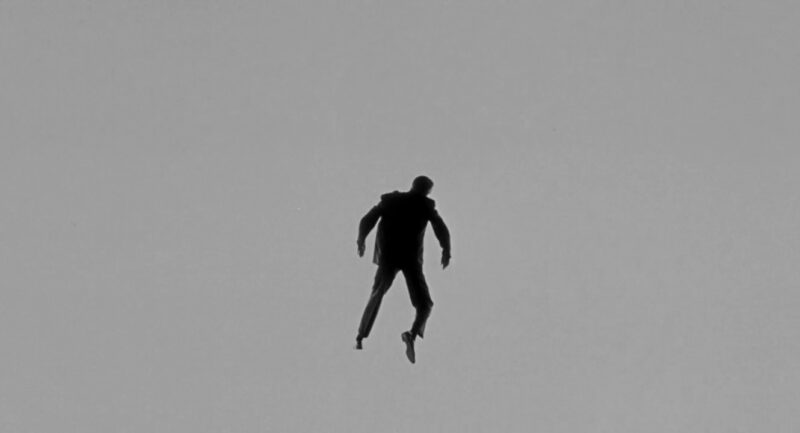
Why does Judy become Madeleine for Scottie?
Judy becomes Madeleine for Scottie largely out of love and desperation. After the staged death of “Madeleine,” Judy finds herself genuinely falling in love with Scottie. Even though she was initially a part of a manipulative scheme, her feelings for Scottie grow to the point where she’s willing to sacrifice her own identity to be with him. When Scottie discovers Judy and becomes obsessed with turning her into the image of Madeleine, Judy agrees to the transformation, despite the potential dangers and the loss of her own identity, in the hope that they might find happiness together.
Her transformation into Madeleine isn’t only a testament to her love for Scottie but also a reflection of Scottie’s obsession. Scottie’s obsessive need to resurrect Madeleine from the dead, to regain what he has lost, leads him to disregard Judy’s true identity. This echoes the film’s broader theme of obsession and its destructive consequences.
Why does Judy wear Carlotta’s necklace?
Judy wears Carlotta’s necklace, a crucial mistake, as it ultimately leads Scottie to uncover the truth about her real identity and the murder scheme. The necklace is an heirloom that was portrayed in Carlotta Valdes’ painting and was supposedly passed down to Madeleine. When Judy wears it, she unintentionally reveals her connection to the staged Madeleine and, consequently, to the whole plot.
The necklace serves as a physical link between the past (Carlotta/Madeleine) and the present (Judy), reflecting the film’s theme of the past’s cyclical and intrusive nature. By wearing the necklace, Judy is not only linking herself to Madeleine but also to the tragic history of Carlotta.
What happens to Midge?
Midge, Scottie’s ex-fiancée, and longtime friend, provides a grounded, real-world contrast to the illusory, idealized figure of Madeleine. She cares deeply for Scottie and attempts to pull him out of his obsession with Madeleine. However, as Scottie’s fixation deepens, Midge realizes she cannot compete with the enigmatic Madeleine and feels helpless in the face of Scottie’s spiraling obsession.
Her final scene shows her in the hospital with a despondent Scottie, listening to Mozart’s Symphony No. 34 in C Major on the radio—an attempt to lift his spirits. After realizing the depth of Scottie’s despair and his inability to return her feelings, Midge quietly leaves the room, effectively removing herself from Scottie’s life.
What happens to Midge afterwards is left ambiguous, as she does not reappear in the film. Her departure can be interpreted as a painful but necessary decision to distance herself from Scottie’s destructive obsession. Despite her love for Scottie, Midge recognizes the impossibility of their relationship as long as Scottie remains fixated on Madeleine.
Now it’s your turn
Have more unanswered questions about Vertigo? Are there themes or motifs we missed? Is there more to explain about the ending? Please post your questions and thoughts in the comments section! We’ll do our best to address every one of them. If we like what you have to say, you could become part of our movie guide!

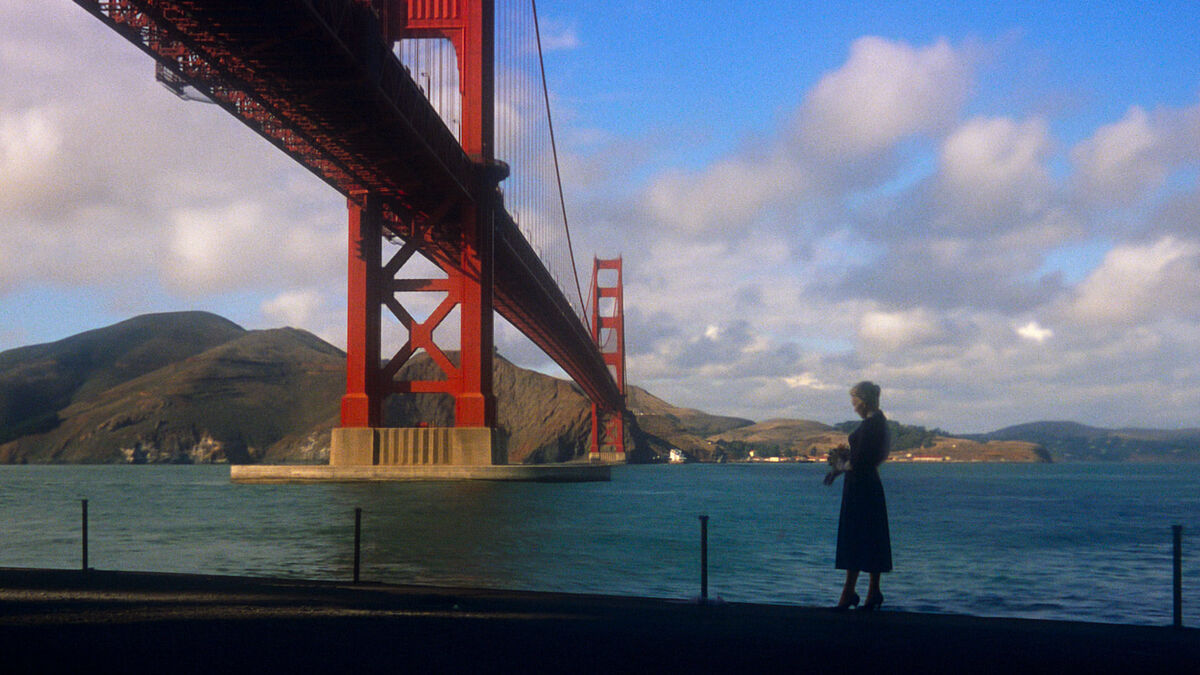
Vertigo during the relationship between Judy and Scottie is unbelievable, because any normally intelligent man of IQ 110 (or less) would quickly have recognized Judy as the same woman who played Madeleine : They were both left-handed, they were the same height and figure, the bone structure and facial appearance were identical, the voices were identical, and the different clothes and hair color were not definitive of different identity.
Second, Judy could not have worked at Menin’s store during her second year in San Francisco, in case Scottie had had enough insight or investigative competence, as a former detective, to inquire. Moreover, “Judy” lived with Garin in his apartment during that second year of her life in California.
Third, granted that Judy genuinely loved Scottie, she would have been quickly honest with him about her accessory to Gavin’s murder of his wife. She would have taken the risk that he would leave; that risk was small. He would not have prosecuted Gavin, because that would have required him to prosecute Judy and she would not have submitted a confession and account of Gavin’s criminal actions to a court; and also have required Scottie to break up with Judy.